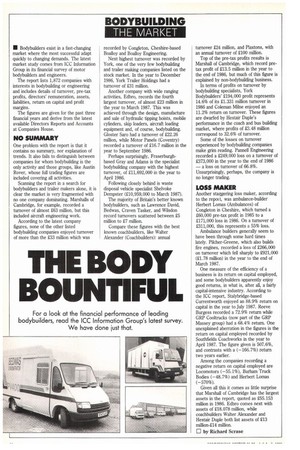BODYBUILDING THE MARKET
Page 46

If you've noticed an error in this article please click here to report it so we can fix it.
• Bodybuilders exist in a fast-changing market where the most successful adapt quickly to changing demands. The latest market study comes from ICC Information Group in its financial survey of motor bodybuilders and engineers.
The report lists 1,872 companies with interests in bodybuilding or engineering and includes details of turnover, pre-tax profits, directors' remuneration, assets, liabilities, return on capital and profit margins.
The figures are given for the past three financial years and derive from the latest available Directors Reports and Accounts at Companies House.
NO SUMMARY
One problem with the report is that it contains no summary, nor explanation of trends. It also fails to distinguish between companies for whom bodybuilding is the only activity and those groups, like Austin Rover, whose full trading figures are included covering all activities.
Scanning the report in a search for bodybuilders and trailer makers alone, it is clear the market is very fragmented with no one company dominating. MarshaMs of Cambridge, for example, recorded a turnover of almost £63 million, but this included aircraft engineering work.
According to the latest company figures, none of the other listed bodybuilding companies enjoyed turnover of more than the 233 million which was recorded by Congleton, Cheshire-based BoaHoy and BoaHoy Engineering.
Next highest turnover was recorded by York, one of the very few bodybuilding and trailer making companies listed on the stock market. In the year to December 1986, York Trailer Holdings had a turnover of 231 million.
Another company with wide ranging activities, Edbro, records the fourth largest turnover, of almost 223 million in the year to March 1987. This was achieved through the design, manufacture and sale of hydraulic tipping hoists, mobile cylinders, skip loaders, aircraft loading equipment and, of course, bodybuilding. Gloster Saro had a turnover of 222.26 million, while Motor Panels (Coventry) recorded a turnover of £16.7 million in the year to September 1986.
Perhaps surprisingly, Fraserburghbased Gray and Adams is the specialist bodybuilding company with the highest turnover, of 211,692,000 in the year to April 1986.
Following closely behind is waste disposal vehicle specialist She!yoke Dempster (210,959,000 to March 1987).
The majority of Britain's better known bodybuilders, such as Lawrence David, Bedwas, Craven Tasker, and Wilsdon record turnovers scattered between £5 million to £7 million.
Compare these figures with the best known coachbaders, like Walter Alexander (Coachbuilders): annual turnover 224 million, and Plaxtons, with an annual turnover of £100 million.
Top of the pre-tax profits results is Marshall of Cambridge, which record pretax profit of 213.5 million in the year to the end of 1986, but much of this figure is explained by non-bodybuilding business.
In terms of profits on turnover by bodybuilding specialists, York Bodybuilders' 2194,000 profit represents 14.6% of its 21.331 million turnover in 1986 and Coleman Milne enjoyed an 11.2% return on turnover. These figures are dwarfed by Hestair Duple's performance in the coach and bus building market, where profits of 23.48 million correspond to 32.6% of turnover.
Some of the losses on turnover experienced by bodybuilding companies make grim reading. Pannell Engineering recorded a 2249,000 loss on a turnover of 2373,000 in the year to the end of 1986 — a loss on turnover of 66.8%. Unsurprisingly, perhaps, the company is no longer trading.
LOSS MAKER
Another staggering loss maker, according to the repoit, was ambulance-builder Herbert Lomas (Ambulances) of Congleton in Cheshire, which turned a £60,000 pre-tax profit in 1985 to a 2171,000 loss in 1986. On a turnover of £311,000, this represents a 55% loss.
Ambulance builders generally seem to have been through some hard times lately. Pilcher-Greene, which also builds fire engines, recorded a loss of £266,000 on turnover which fell sharply to 2921,000 (21.78 million) in the year to the end of March 1987.
One measure of the efficiency of a business is its return on capital employed, and some bodybuilders apparently enjoy good returns, in what is, after all, a fairly capital-intensive industry. According to the ICC report, Stalybridge-based Currentworth enjoyed an 88.9% return on capital in the year to July 1987. Reeve Burgess recorded a 72.9% return while GRP Cooltrucks (now part of the GRP Massey group) had a 68.4% return. One unexplained aberration in the figures is the return on capital employed recorded by Southfields Coachworks in the year to April 1987. The figure given is 507.6%, and contrasts with a (-166.7%) return two years earlier.
Among the companies recording a negative return on capital employed are Locomotors (-55.1%), Barham Truck Bodies (-48.7%) and Herbert Lomas (-570%).
Given all this it comes as little surprise that Marshall of Cambridge has the largest assets in the report, quoted as £55.153 Million in 1986. Edbro comes next with assets of £18.078 million, while coachbuilders Walter Alexander and Hestair Duple both list assets of 213 million-214 million.
D by Richard Scrase
















































































































































